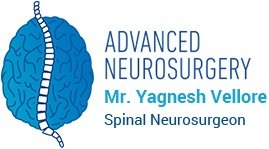Spondylolisthesis
Spondylolisthesis is a condition in which a vertebra slips forward, over the underlying vertebra. This is more common in the lower back (lumbar region of the spine). Spondylolisthesis due to degenerative changes of ageing is known as degenerative spondylolisthesis. It is more common in individuals above 50 years of age with a female predisposition.
Causes
Due to advancing age, degenerative changes in the spine begin to cumulate. These changes adversely affect the structural components of the spine such as intervertebral discs, facet joints, vertebrae and ligaments.
Degenerative changes in the intervertebral disc reduce its thickness due to a reduction in the water content. The reduction in the height of these intervertebral discs reduces their ability to absorb shock leading to increased pressure at the facet joints and vertebrae. The facet joints develop osteoarthritis and weaken. The degenerative changes also cause a thickening and laxity of the ligaments, the soft tissues holding the vertebrae in place. Ligamentum flavum, the ligament present over the back of the spine, may also be affected.
A combination of these degenerative changes causes a disruption of the normal vertebral alignment, causing one vertebrae to slide forward over the other. Although poor posture, overweight, repetitive movement and trauma or injury may not cause degenerative spondylolisthesis, they can aggravate the condition.
Symptoms
The forward displacement of the vertebrae results in narrowing of the spinal canal at the displacement site. This results in compression of the spinal cord and the spinal nerves leading to symptoms like stenosis, a condition that results from narrowing of the spinal canal. The common symptoms of degenerative spondylolisthesis include back pain, leg pain, weakness of arm or leg, feeling of numbness or tingling in the legs, muscle spasms, tight hamstring muscles and improper gait or limp. Sitting or bending forward slightly relaxes the spinal canal and relieves the symptoms whereas standing and walking constricts the spinal canal aggravating the symptoms. In rare cases, degenerative spondylolisthesis may also result in loss of bladder or bowel function which is a medical emergency.
Diagnosis
Diagnosis of degenerative spondylolisthesis involves medical history along with physical and neurological examinations. X-ray of the spine may be required for a confirmation of the diagnosis. Loss of disc height, bone spurs and even the slipped vertebrae are clearly visible in an X-ray report. Other imaging tests such as MRI and CT scan may also be performed. MRI is usually performed to assess a compression of the nerves.
Treatment
The common nonsurgical treatments employed include brief period of rest, activity modification, pain medications, non-steroidal anti-inflammatory drugs (NSAIDs), muscle relaxants, spinal injection and physical therapy. Back braces may also be recommended to support the back and reduce mechanical pain due to movement. Acupuncture may also be beneficial in few cases.
Spinal surgery is recommended in patients who do not respond to non-surgical treatment even after 3 to 6 months or those with spinal instability and neurologic dysfunction.
The surgery for degenerative spondylolisthesis involves laminectomy and spinal fusion. Laminectomy relaxes the spinal canal reducing the pressure on the nerves and relieving the symptoms. Spinal fusion involves the fusion of painful, displaced vertebrae into a single unit with screws; thereby stabilizing the spine.
Consult your doctor for any queries about degenerative spondylolisthesis and its treatment.

